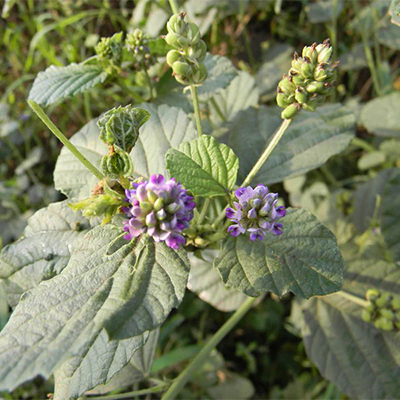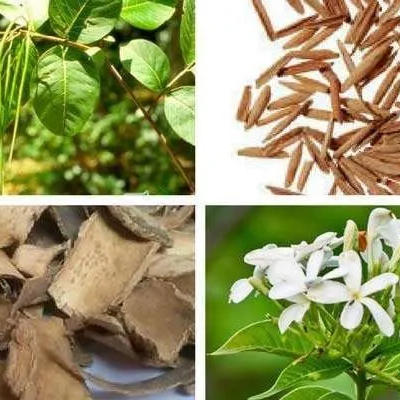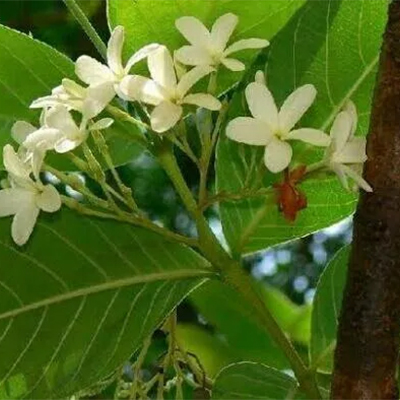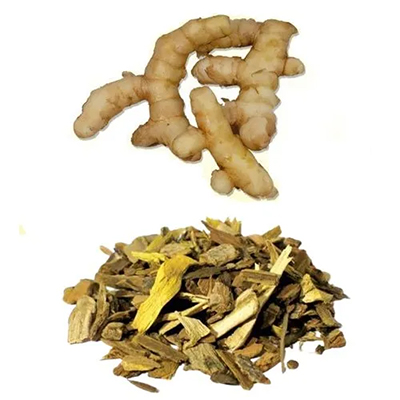On This Page
Bakuchi (Psoralea corylifolia) – A Powerful Skin Healing Herb
Introduction
Bakuchi has been used from past hundreds of years and is considered as the most conventional herb. It is the most popular drug for Shwitra and Kustha which is botanically known as Psoralea corylifolia and is an erect annual herb. Recent research revealed that Bakuchi exhibits anti-diabetic, antioxidant, anti-inflammatory properties, etc due to which it is used in various skin disorders, wound healing, teeth disorder, hair loss, etc. Each part of Psoralea corylifolia has its own therapeutic importance.
Basonym of Bakuchi
वाग्भिः कुच्यते शब्द्यते स्तूयते प्रशस्तगुणत्वात् ।
A reputed drug for its use in Shwitra.
Synonyms of Bakuchi
- According to morphology
सुपर्णिका- शोभनानि पर्णा अन्य अस्या: ।
The plant possesses beautiful leaves.
कालमेषी- काल मिषति स्पर्धते, कृष्णफलेत्यर्थः ।
The fruits are black.
कृष्णफला- कृष्णं फलमस्या: ।
The fruits are black.
पूतिफला- पूति दुर्गन्धि फलमस्याः ।
Fruits have a characteristic offensive odor.
शशिलेखा-चन्द्रस्येव रेखाइ स्याम् ।
Seeds have a white streak.
- According to properties and action
कुष्ठघनी – कुष्ठं हन्तीति ।
Bakuchi is efficacious in Kustha.
श्वित्रघनी – श्वित्रमहन्तीति ।
It cures Shwitra (vitiligo).
मलयू: – मलम श्वित्रम याँति पृथक करोतीति।
It destroys Shwitra.
अवल्गुजा- अवल्गु अशोभनम अङ्गम वल्गु शोभने जनयतीति।
Imparts color and luster to a person suffering from Shwitra.
Regional Names of Bakuchi
- Psoralea seed, purple fleabane (English)
- Habuch (Bengali)
- Bavachi (Gujarati)
- Babchi (Hindi)
- Bavanchi (Kannada)
- Karpokkari (Malayalam)
- Bavachya, Babchi (Marathi)
- Bavachi (Punjabi)
- Karpokarishi (Tamil)
- Bhavanchi (Telugu)
Botanical Name
Psoralea corylifolia Linn.
Psoralea means plants with a rough surface due to glandular dots or warts.
Corylifolia is derived from the Greek word korus which means helmet, calcine covering the nut.
Family
Papillionaceae/ Fabaceae (Aprajita Kula)
Ayurveda Reference for Bakuchi (Psoralea corylifolia)

Scientific Classification of Bakuchi
| Kingdom | Plantae |
| Class | Dicotyledons |
| Subclass | Polypetalae |
| Series | Calyciflorae |
| Order | Rosales |
| Family | Papillionaceae (Fabaceae) |
| Genus | Psoralea |
| Species | corylifolia |
Classification of Bakuchi as per Charaka and Sushruta
- Charaka: Tikat Sakandha
- Sushruta: Katu Varga
Bakuchi’s Description in Brihtrayi
- Sushruta Samhita: S. S. Chi. 9/ 32, S. S. Chi. 25/ 18
- Vaghbhata (Ashtanga Hridya): A. H. Chi. 9/ 21. A. H. Chi. 19/ 45, 53, A. H. U. 18/ 45
Bakuchi’s Description in Brihtrayi as Synonym Avalguja
| Charaka | Shusruta | Vagbhata
(Ashtang Hridya) |
| C. S. Su. 27/ 32, 93, 99 | S. S. Su. 42/ 18 | A. H. Su. 6/ 75, 82 |
| C. S. Vi. 8/ 150 | S. S. Su. 46/ 265 | A. H. Su. 7/ 26 |
| C. S. Chi. 7/ 168, 169, 170 | S. S. Chi. 9/ 5, 10, 21, 25, 27, 37 | A. H. Chi. 20/ 13, 14 |
| C. S. Chi. 14/ 124 | S. S. Chi. 10/ 4, 14 | |
| C. S. Chi. 19/ 35 | S. S. Chi. 25/ 15 | |
| S. S. Chi. 28/ 3 | ||
| S. S. Chi. 31/ 5 |
Bakuchi’s Description in Brihtrayi as Synonym Induraji
Vaghbhata (Ashtanga Hridya): A. H. U. 1/ 43
Bakuchi’s Description in Brihtrayi as Synonym Chandralekha
Vaghbhata (Ashtanga Hridya): A. H. Chi. 3/ 135
Bakuchi’s Description in Brihtrayi as Synonym Shashanklekha
Vaghbhata (Ashtanga Hridya): A. H. Chi. 19/ 46
Bakuchi’s Description in Brihtrayi as Synonym Somraji
- Charaka Samhita: C. S. Su. 2/ 23, C. S. Chi. 23/ 79, C. S. Chi. 26/ 269
- Sushruta Samhita: S. S. Ka. 5/ 84, S. S. Ka. 6/ 18
- Vaghbhata (Ashtanga Hridya): A. H. Chi. 19/ 47, A. H. U. 36/ 91, A. H. U. 39/ 107, 108
Historical Background of Bakuchi
None of the synonyms of Bakuchi are traceable from the Vedic literature. Though Somavati is described in Rigveda (R.V. 10/ 97/ 7). Its identity with P. corylifolia is not established. In Charaka Samhita the name Kusthaghna is used for Khadira or Prapunnada but not for Bakuchi (C. S. Ci. 23/ 53). Avalguja is the undisputed name of this plant in Brihatrayi. Even the popular synonym Somaraji is questioned by scholars like Thakurji. The tribal name Sevaraja in the forest areas of Bihar for Vernonia anthelmintic will (C. anthelminticum) may also be considered for Somaraji according to Thakurji. There are two important properties for Bakuci i.e, Visaghna and Shavitranasana. Therefore, there is some possibility for a description of two varieties of Bakuci in classical literature. It will be quite interesting to note that Caraka did not describe this plant with the name Bakuchi, only Suruta and Vagbhata have delineated this synonym a few times (S. S. Ci. 9/ 32, S. S. Ci. 25/ 18, A. H. Ci. 9/ 21, A. H. Ci. 19/ 45 & A. H. Ut. 18/ 45). P.V. Sharmaji thinks that Nighantus made Somaraji the synonym of Bakuchi. Other texts have created confusion by considering Somaraji as Kalajaji as well as Bakuchi. But at present, it is identified that Bakuchi/ Somaraji is P. Corylifolia.
External Morphology of Psoralea corylifolia
- Habit – Bakuchi is an erect annual herb that grows 60-180 cm in height. The trunk is straight and gland-dotted. Branches are strong and elastic.
- Leaves – Leaves of Bakuchi are alternate, simple, and covered with numerous black dots. 3-8 cm long and 2.5 to 5 cm broad. Round or heart-shaped, scallop toothed with mucronate apex. 5 main nerves spring from the base and 4-to 6 pairs of lateral nerves spring higher up of the leaf. The petiole is 1- 2.5 cm long.
- Inflorescence – Axillary 10- 30 flowered racemose.
- Flowers – Bluish purple in the color, long peduncle, and short pedicels. Calyx 3-4 mm long, gamosepalous. Corolla is twice as long as calyx, the standard petal is orbicular 6 mm long, clawed, the wing petal is oblong and the keel petal is obtuse. Androecium contains 10 stamens. Gynoecium has a monocarpellary ovary with a long style and a minute terminal stigma.
- Fruit – A small blackish, glabrous, ovoid or kidney-shaped, compressed, closely pitted one-seeded indehiscent legume. Pods are 5 mm long.
- Seeds – Smooth, small, adhering to pericarp, somewhat ovate with an agreeable aroma.
Flowering and fruiting time
Flowers in March-June and fruits occur from October to February.
The Distribution of Bakuchi
Bakuchi is found almost throughout India as a weed of waste. Sometimes Bakuchi is cultivated in Pakistan and Ceylon. It is grown in various regions of the country, especially in Uttar Pradesh and Assam.
The Useful Part of Bakuchi
Seed
Fruit is a one-seeded, indehiscent pod, measuring up to 5 mm in length and 3.5 mm in breadth. These are ovoid, oblong, somewhat compressed, or flattened. The surface of the pericarp which closely adheres to the seed is glabrous, closely pitted, having dark chocolate to almost black pitted, having dark chocolate to almost black color. The entire pod, in most cases, is found to be enclosed within a membranous persistent calyx which is adherent to the fruit. The seed is also black and contains two starchless cotyledons. Odor is faint, which turns pungent on chewing, having an acrid, bitter taste, and is nauseating.
Important Phytoconstituent of Psoralea corylifolia
Fruits and seeds have essential oil (0.05%), resin (8.9%), brown fixed oil (10%), raffinose compounds, coumarin compounds, psoralen, iso- psoralidin, psoralidin, corylifolin, bavachromanol, psoralenol.
Recent Research on Bakuchi
- Antifungal activity of petroleum ether extract of Psoralea corylifolia L. seed, tested against Fusarium sp. namely, Fusarium oxysporum, Fusarium moniliforme, and Fusarium graminearum, was evaluated by agar well diffusion assay and showed potent antifungal activity with a minimum inhibitory concentration of 1 mg/mL against Fusarium sp. Srinivasan S, Sarada DV. Antifungal activity of Phenyl Derivative of Pyranocoumarin from Psoralea corylifolia L. Seeds by inhibition of Acetylaton Activity of Trichothecene 3-O-Acetyltransferase (Tri 101). J. Biomed Biotechnol. 2012; 2012:310850. Epub 2012 Jun 21.
- The seeds of Psoralea corylifolia L., an important medicinal herb in Indian Pharmacopoeia have shown antioxidant modulation in response to gamma radiation-induced oxidative stress. Jan. S, Parween T, Siddigi Mahmooduzzafar. Antioxidant modulation in response to gamma radiation-induced oxidative stress in developing seedlings of Psoralea corylifolia L. J. Environ Radioact. 2012. Jun 20:113C:142-149.
- Psoralen and isopsoralen constituents of Psoralea corylifolia L. contribute to its anticancer effect. Wang Y, Hong C, Zhou C, Xu D, Qu HB. Screening Antitumour Compounds Psoralen and Isopsoralen from Psoralea corylifolia L. Seeds. Evid. Based Complement Alternate Med. 2011; 2011:363052. Epub 2011 Mar 10.
- The antidepressant-like effects of psoralidin isolated from the seeds of Psoralea corylifolia were investigated in the forced swimming test (FST) in the ICR strain of male mice. Results suggested that psoralidin possessed potent antidepressant-like properties that were mediated via the monoamine neurotransmitter and the hypothalamic-pituitary-adrenal (HPA) axis systems. Yi LT, Li YC, Pan Y, Li JM, Xu Q, Mo SF, Qiao CF, Jiang FX, Xu, HX, LU, XB, Kong LD, Kung HF. Antidepressant-like effects of psoralidin isolated from the seeds of Psoralea Corylifolia in the forced swimming test in mice. Prog Neuropsychopharmacol Biol Psychiatry. 2008 Feb 15;32(2):510-9. Epub 2007 Oct 16.
- A new biologically active flavonol glycoside (1) mp 264- 265 degrees C, C32H38020, (M)+742 (EIMS) has been isolated from the methanol-soluble fraction of the defatted seeds of Psoralea corylifolia (Linn). which showed antimicrobial activity against various bacteria and fungi Yadava RN, Verma V. A new biologically active flavonol glycoside from Psoralea corylifolia (Linn.). J Asian Nat Prod Res. 2005 Aug; 7(4): 671-5.
- Psoralidin, Bakuchicin, Psoralin, and Angelicin, isolated from the seeds of Psoralea corylifolia, showed significant antibacterial activities against several Gram (+) and Gram (-) bacteria. Khatune NA, Islam ME, Haque ME, Khondkar P, Rahman MM. Antibacterial compounds from the seeds of Psoralea corylifolia Fitoterapia. 2004 Mar; 75(2):228-30.
Rasa Panchaka of Bakuchi
| Rasa (Taste) | Tikata (bitter), Madhura (sweet), [Kashaya (astringent) by Kaiydeva Nighantu] |
| Guna (Virtue) | Laghu (light), Ruksha (dry), Sara (Mobility) |
| Virya (potency) | Sheet (cold potency), [Ushana (hot potency) by Raja Nighantu] |
| Vipaka (post-digestion) | Katu (pungent) |
Dosha Karma of Bakuchi
Kapha-Pitta Hara
Kapha Hara because of Katu Vipaka and Tikat Rasa.
Pitta Hara because of Tikata, Madhura Rasa, and Sheeta Virya.
Karma (Actions) of Bakuchi
Bija – Shwitra Ghana, Rasayana, Ruchya, Hridya, Swasahara, Kusth Ghana, Mehahara, Krmi Ghana, Medhya, Dipaniya, Kandu Ghana.
Phala – Kustha Ghana, Keshya, Twachya, Krmi Ghana, Swashahara, Kasahara, Sothahara.
Prayogarha Vyadhi (Therapeutic Indication) of Bakuchi
Bija:-
- Kustha
- Meha
- Jwara
- Shwitra
- Visha
- Kandu
- Kasa
- Swasha
Phala:-
- Kesha Vikara
- Twaka Roga
- Kustha
- Kasa
- Shotha
- Krimi
- Swasha
- Pandu
Aamyik Prayog (Therapeutic Uses) of Bakuchi
Kustha (skin disorder):
- Tuvaraka seeds, Bhallataka, Bakuchi, Chitraka root, and Shilajatu should be used according to the method of Rasayana to cure skin disorders (Kustha). (Ashtanga Hridya Chikitsa Sthana. 19/ 53)
- Bakuchi should be taken with warm water (Ushana Jala) and the patient is exposed to the sun while keeping on a milk diet (Keval Digdha Aahara). Thus, he gets rid of the skin disease. (Vrinda Madhava. 51/ 46)
- Bakuchi seeds should be taken in 10 gm amount with hot water keeping on the diet with milk (Dugadha) and clarified butter (Ghrita). This is an excellent remedy for all types of Kustha. (Vanga Sena Kustha. 101)
- An ointment with the powder of Bakuchi mixed with Sunthi destroys severe and chronic Kustha. (Bhava Prakasha Samhita Chikitsa Sthana. 54/ 53)
Shvitra (Vitiligo):
- Ayaskrti of Khadira heartwood is efficacious for skin diseases and vitiligo. Similar is the Bakuchi seed taken with the decoction of Bibhitaki bark and Kakodumbara. (Chakradutta. 216)
- Bakuchi seeds 160 gm with Haritala 40 gm pounded with cow- urine restores normal color in vitiligo. (Vrinda Madhava. 51/ 33)
- Decoction of Amalaki and Khadira (heartwood) added with Bakuchi powder should be used regularly keeping on a wholesome diet. It alleviates vitiligo. (Sharangdhara Samhita. 2/ 2. 137, Vanga Sena. Kustha. 29)
- Bakuchi is put in the decoction of Bibhitaka bark overnight, then pounded and taken with oil. It destroys Vitiligo and Kustha. (Vaidya Manorma. 11/ 63)
- Milk is curdled in an earthen vessel pasted inside with the powder of Bakuchi. Ghee extracted from this should be taken with honey followed by intake of buttermilk. It destroys vitiligo. (Raja Amrittanda. 8/ 7)
Kshudra Kustha Roga (Minor skin diseases): Intake of Tila 1 part with Bakuci 2 parts daily destroys ringworm. (Raja Amrittanda. 8/ 3)
Rasayana (Rejuvenator):
- Shweta Avalguja Phala Rasayana. (Sushruta Samhita Chikitsa Sthana. 28/ 3)
- Bakuchi- Rasayana. (Ashtanga Sangreha Uttara Tantra. 49/ 147- 55)
- Somaraji- Rasayana. (Ashtanga Hridya Uttara tantra. 39/ 107- 10)
Vishakta (Poisoning): Gruel cooked with Bakuchi is useful in poisoning. (Charaka Samhita Sutra Sthana. 2/ 24)
Garbha Dharana (For conception): A woman taking Bakuci with ghee along with warm water in menstrual period keeping on the diet with milk processed with Ashwagandha gets male progeny. (Ashtanga Sangreha Uttara Tantra. 49/ 92)
Atisaara (Dysentery): Leaves of Bakuchi cooked with curd and pomegranate and added with ample ghee are used as a vegetable. (Charaka Samhita chikitsa Sthana. 19/ 30- 33)
Dant Krimi (Caries): Roots of Bijapur and Bakuchi in equal quantity are pounded and made into a paste. It is pressed under the teeth which relieves pain in caries. (Vanga Sena. Danta. 98- 99)
Badhirya (Deafness): One should take powder of Musali and Bakuci for treatment of deafness. (Vanga Sena Karna. 85)
Shleepada (Filaria): Decoction of Bakuchi destroys filaria. (Gada Nigreha. 4. 2. 38)
Vrana (Wound): Application of the paste of Bakuchi leaves checks hemorrhage in Wounds. (Vaidya Manorma. 16/ 119)
Benefits of Bakuchi
- Vitiligo (Shvitra): Shvitra (Vitiligo) is caused by vitiated Pitta and the formation of Ama which impairs deeper body tissues. Bakuchi with its Kustha Ghana properties shrinks the white patches and helps in quick healing with its Ropana properties.
- Hair loss (Khalitya): Bakuchi with its Keshya properties removes dandruff and also improves hair growth. Thus, helps to treat hair loss.
- Strengthen bones: Bakuchi with its Kapha Ghana properties and high content of calcium promotes bone calcification.
- Wound (Vrana): Bakuchi with its Ropana properties helps in the quick healing of Vrana (wound).
Matra (Therapeutic Administration and Dosage) of Bakuchi
- Churna (Powder) – 1-3 grams (internally), sufficient quantity externally can be used as per requirement.

Have A Health Issue?
Consult Online
- Dr. Sahil Gupta (B.A.M.S., M.H.A.)
Ayurvedic Allergy Specialist
CEO & Founder of IAFA®
Classical Reference of Bakuchi
Bhava Prakasha Nighantu Haritkyadi Varga- 206- 207
Synonyms
अवल्गुजो बाकुची स्यात्सोमराजी सुपर्णिका ।
शशिलेखाकृष्णफला सोमा पूतिफलीति च ।।
सोमंवल्ली कालमेषी कुष्ठघ्नी च प्रकीर्तिता ।।
Bhava Prakasha Nighantu Haritkyadi Varga- 207- 209
Properties and action
बाकुची मधुरातिक्ता कटुपाका रसायनी ।
विष्टम्महतृहिमा रुच्या सरा शलेष्मास्रपित्तनुत ।।
रूक्षा हद्या श्वासकुष्ठ मेहज्वर कृमि प्रणुत् ।।
तत्फलं पित्तलं कुष्ठकफानिलहरं कटु ।
केश्यं त्वच्यकृमिश्वासकास शोथाम पाण्डुनुत् ।।
Dhanwantri Nighantu Guduchyadi Varga, 164
बाकुची शीतला तिक्ता शलेष्म कुष्ठक्रमीञ्चयेत् ।
रसायनोपयुक्ता च रुचिमेधा विवर्धनी।।
Kaiydeva Nighantu Aushadi Varga, 706- 708
बाकुची तुवरा तिक्ता कटुपाका हिमा लघु: ।
दीपनी मधुरा रुक्षा रुच्या हद्या रसायनी ।।
विष्टम्भिनी सरा मेध्या रक्तपित्तकफापहा ।
फल केश्य कृष्ठकृमिश्वासकासमेहज्वरारुची: ।।
फलं केश्यं त्वच्यं कृमि श्वास शोथ पाण्डु हत।
Raja Nighantu Shathavadi Varga- 65
बाकुची कटु तिक्तोष्णा कृमि कुष्ठ कफापहा।
त्वग्दोषविषकण्डूतिखर्जु प्रशमनी च सा ।।
Priya Nighantu, Shatpushpadi Varga, 166
बाकुची सोमराजी स्यात श्वित्रघनि परमौषधि: ।
तिक्त बीजं हितम श्वित्रे लेपनाद भक्षणाद अपि।।
Ashtanga Hridya Chikitsa Sthana. 19/ 53
कुष्ठ
रसायनप्रयोगेण तुवरा स्थिनी शीलयेत्।
भल्लातकं बाकुचिकाम वह्नि मूलं शिलाहयम्।।
Vrinda Madhava. 51/ 46
घर्मसेवी कटु उष्णेन वारिणा बाकुचीम पिबेत्।
क्षीरभोजी त्रि सप्ताहात कुष्ठ रोगात् प्रमुच्यते।।
Vanga Sena, Kustha, 101
अवल्गुजाद् बीजकर्ष पिबेदुष्णेन वारिणा।
भोजन क्षीरसर्पिभ्या सर्वकु्हहरं परम्।।
Bhava Prakasha Samhita Chikitsa Sthana. 54/ 53
सोमराजीभवं चूर्ण श्रृंगबेरसमन्वितम्।
उद्वर्तनमिद हन्ति कुष्ठमुग्र कृतास्पदम्।।
श्वित्र
अयस्कृतिवां खदिरस्य सार: त्वगदोषिणां श्वित्रविकारिणाञ्च |
आवल्गुजं बीजमुदाहरन्ति बिभीतक त्वक मल यूष कषाये: ।
Vrinda Madhava. 51/ 33
कुडवो अवलगुज बीजाद्धरितालचतुर्थभागसंमिश्र: ।
मूत्रेण गवां पिष्ट: सवर्णकरणः पर: श्वित्रे।।
Sharangdhara Samhita. 2. 2. 137
क्वाथो अवल्गुजचूर्णादयो धात्रीखदिरसारयो: ।
जयेत् सुशीलितो नित्य श्वित्रम पथ्याशिनां नृणाम्।।
Vaidya Manorma. 11/ 63
कलित्वक्साधिते तोये वासिता निशि बाकुची।
पिष्द्वा तैलेन पीता च श्वित्र कुष्ठविनाशिनी।।
Raja Amrittanda. 8/ 7
चूर्णेन भाण्डमुपलिप्य शशांक राज्या: तत्र स्थितेन पयसा दथि संविदध्यात्।
स्नेह तदीयमसकृन् मधुनोपयुज्य श्वित्रम नरो जयति तन्मथितानुपानात्।।
Raja Amrittanda. 8/ 3
क्षुद्ररोगे
भागं तिलानां सह सोमराज्या भागद्व्येन प्रतिवासरं य: ।
अम्नाति तस्य द्रुतमदद्रुश्चिर प्ररूढापि विनाशमेति।।
Shusruta Samhita Chikitsa Sthana. 28/ 3
रसायने
श्वेता अवल्गुजफल-रसायनम्।
Ashtanga Sangreha Uttara Tantra. 49/ 147- 155
बाकुची-रसायनम्।
Ashtanga Sangreha Uttara Tantra. 39/ 107- 110
सोमराजी-रसायनम्।
Charaka Samhita Sutra Sthana. 2/ 24
विषे
विषघ्नी च सोमराजी विपाचिता।
Ashtanga Sangreha Uttara Tantra. 49/ 92
गर्भजननार्थम
लेखामिन्दो: सघृता सुखाम्बुना पुत्रिणी भवति पीत्वा।
पुष्योदये अश्वगन्धाशृतेन पयसा च भुज्जाना।।
Charaka Samhita Chikitsa Sthana. 19/ 30- 33
प्रवाहिकायाम्
दधि दाडिमसिद्धेन बहुस्नेहेन भोजयेत्।।
Vanga Sena Danta Roga, 98- 99
क्रिमिदन्त रुजा
बीजपूरकमूलस्य बाकुचीनां तथेव च।
भागाभ्यां तु समं कृत्वा पिष्टा वर्ति तु कारयेत।।
एवा रदस्थवर्तिस्तु दन्तैरदंतै निपीड्येट।
सद्यो अव्स्थितमात्रा तु क्रिमिदन्तरुजापहा।।
Vanga Sena Karna Roga. 85
वाधिर्य
मुशलीबाकुचीचूर्ण खादेद् बाधिर्य शान्तये।
Gada Nigreha. 4. 2. 38
श्लीपदे
श्लीपदं नश्यति क्षिप्र सोमराजीजलेन वा।
Vaidya Manorma. 16/ 119
व्रण
सोमराज्याश्च पल्लवै: ।
बध्नाति बन्धन क्षुण्णै: ब्रणे शोणितनि:सुतिम्।।
Specific Formulation of Bakuchi
- Somraji Taila for Shwitra, Kandu
- Vidangadi Churna for Kustha
- Nila Ghrita for Kustha and Tvaka Roga
- Somraji Ghrita for Shwitra
- Shashilekha Vati for Kustha
- Panchanana Taila for Shweta Kustha
- Maha Neel Taila
- Khadirarishta
Contraindication and Side Effects of Bakuchi
Oral administration has resulted in nausea, vomiting, malaise, loose motion, and headache. The oil extracted from Bakuchi has a specific irritant action on the mucous membrane and skin. On applying leukoderma, the skin becomes reddish and occasionally blisters may occur.
It is advised to use Bakuchi in pregnant women, lactating mothers, and children under medical supervision.
Dadhi (curd), Matsya (fish), and Pickles should be avoided during the use of Bakuchi.
Suggestive Reading Regarding Bakuchi
- Bahatkar, Gayatri & Jadhao, Monika & Kamdi, Payal & Parwe, Shweta. (2021). An Ayurvedic and Modern Review on Valued Medicinal Plant -Bakuchi (Psoralea corylifolia Linn.). Drugs and Cell Therapies in Hematology. 10. 3730-3737.
- Suhashini. R, Sindhu.S2, Sagadevan.E3; International Journal of Pharmacognosy and Phytochemical Research; In-vitro Evaluation of Antidiabetic Potential and Phytochemical Profile of Psoralea corylifolia Seeds; Vol 6, Issue 2, June-August 2014, 414-419.
- Khushboo P.S., Jadhav V. M., Kadam V. J., and Sathe N. S.; Pharmacognosy Reviews; Psoralea corylifolia Linn.—“Kushtanashini”2010 Jan-Jun; 4(7): 69–76.
- Pathak J, Acharya R. BAKUCHI (Psoralea corylifolia L.) IN THE CLASSICAL TEXTS OF AYURVEDA: A COMPREHENSIVE REVIEW. J Res Educ Indian Med. Online First: 18 Sep 2019. doi:10.5455/JREIM.82-1556856304
- Gangadhar T. Aralelimath, Shraddha U. Nayak, Gireesh M. Ankad, Harsha V. Hegde, & S S Shirurmath. (2019). AN EXPERIMENTAL STUDY OF VRIKSHAYURVEDA SEED TREATMENTS ON GERMINATION RATE AND ACTIVE INGREDIENT OF BAKUCHI (PSORALEA CORYLIFOLIA LINN.) BY HPLC METHOD. International Journal of Ayurveda and Pharma Research, 7(6), 1-10. Retrieved from https://ijapr.in/index.php/ijapr/article/view/1233.
- Gangadhar T. Aralelimath, Shraddha U. Nayak, Gireesh M. Ankad, Harsha V. Hegde, & S S Shirurmath. (2019). AN EXPERIMENTAL STUDY OF VRIKSHAYURVEDA SEED TREATMENTS ON GERMINATION RATE AND ACTIVE INGREDIENT OF BAKUCHI (PSORALEA CORYLIFOLIA LINN.) BY HPLC METHOD. International Journal of Ayurveda and Pharma Research, 7(6), 1-10. Retrieved from https://ijapr.in/index.php/ijapr/article/view/1233.
- B Manohar, Dr. K Uday Shankar, Characterisation of bioactive components from Chiba seeds (Psoralea corylifolia) extract obtained by supercritical carbon dioxide, Food engineering department, 2010, pg.no-6.
- Sarika Makwana, Nikhil Mehere, Swapnil Chaudhary, Prashant Bedarkar, Pro Biswajyoti Patgiri, & C. R. Harisha. (2022). Comparative Pharmacognostical Evaluation of Ashodhita and Gomutra Shodhita Bakuchi (Psoralea corylifolia Linn.) Seed. Asian Pacific Journal of Health Sciences, 9(1), 251–254. https://doi.org/10.21276/apjhs.2022.9.1.57.
- Dr. Sanjeev Bhagat, Dr. Tapas Brata Tripathy, & Dr. Swati Sharma. (2019). Effect of Gomutra Bhavita Bakuchi Churna Lepa on Shwitra – A Case Study. Journal of Ayurveda and Integrated Medical Sciences, 4(01), 121 – 123. Retrieved from https://www.jaims.in/jaims/article/view/584.
- Verma, n. & (2019) Bakuchi (Psoralea corylifolia) in Oral Diseases. Annals of Ayurvedic Medicine, 8 (1-2), 62-63.
- Khandekar, Anuradha, et al. “Management of vitiligo: An ayurvedic perspective.” Indian Journal of Drugs in Dermatology, vol. 1, no. 1, Jan.-June 2015, p.41.
References
- Agnivesha, Charaka, Dridhabala. In: Charaka Samhita, ed. Vaidya Jadavaji Trikamji Aacharya., editor. Varanasi: Chaukhamba Sanskrit Sansthan; 2009.
- Sushruta. In: Sushruta Samhita, Sutra Sthana, ed. Vaidya Jadavji Trikamji Acharya., editor. Varanasi: Choukhambha Orientalia; 2005.
- Vagbhata. In: Ashtanga Hrudaya, 9th ed. Anna Moreshwar Kunte, Krishnashastri Navarre, Harishastri, editors. Varanasi: Choukhambha Orientalia; 2005.
- Bhavamishra. In: Bhava Prakasha Nighantu, Haritkyadi Varga 11th ed. part 2. Brahma Shankara Mishra., editor. Varanasi: Choukhambha Bharati Academy; 2009.
- Bhavprakasha, commentary by Bulusu Sitaram, forwarded by K.C.Chunekar
- Sharma PV, Kaideva Nighantu. Aushadhi Varga. Chaukhamba Orientalia, Varanasi; 2006:
- Tripathi I., Raja Nighantu, Shathavadi Varga, Chaukhamba Krishnadas Academy; Varanasi; 2010
- Dhanwantri Nighantu, Guduchyadi Varga
- P.V. Sharma, Priya Nighantu, Shatpushpadi Varga, Chaukhamba Krishnadas Academy; Varanasi.
- Dr. Gyanendra Pandey, Dravyaguna Vigyana, reprint 2012, Chawkhamba Krishnadas Academy
- K. Niteshwar Dravyaguna Vigyan, reprint 2017.
- Dr. J.L.N. Sastry and Dr. B.S. Sastry, Dravyaguna Vigyana, Chaukhambha Orientalia, Varanasi.
- Chakrapanidatta, Chakradatta with the vaidaya Prabha hindi commentary by indra deva tripathi, chaukambha sankrita sansthan, varanasi 2nd Edition, 1994.
Ayurveda is an Indian system of medicine that is popular since ancient times. Dr. Gupta’s IAFA® has been conducting research studies to find out different phytoconstituents of herbs and their action in the body. Such knowledge acquired by our experts is used in the preparation of medicines and providing the treatment facilities safely and effectively. IAFA® is the provider of safe and effective treatment for a wide range of diseases, mainly allergic diseases all based on Ayurveda.











